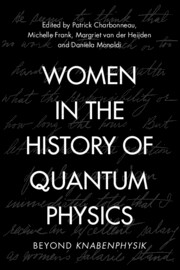Book contents
- Women in the History of Quantum Physics
- Women in the History of Quantum Physics
- Copyright page
- Contents
- Contributors
- Foreword
- Introduction
- 1 The Spectrum of He+ as a Proving Ground for Bohr’s Model of the Atom: A Legacy of Williamina Fleming’s Astrophysical Discovery
- 2 H. Johanna van Leeuwen, the Other Scientist behind the Bohr–Van Leeuwen Theorem
- 3 Hertha Sponer, Maven of Quantum Spectroscopy
- 4 Angular and Career Momentum: What Lucy Mensing Contributed to Physics and Why She Left the Field
- 5 Discouraging Jane: Dewey Among the Lucky Generation of US Physicists
- 6 Laura Chalk and the Stark Effect
- 7 Elizabeth Monroe Boggs: From Quantum Chemistry to the Manhattan Project
- 8 Excelsior! John Wheeler, Katharine Way, and the Role of Women in the Exploration of the Microcosm
- 9 Sonja Ashauer from São Paulo to Cambridge: A Journey to Quantum Electrodynamics
- 10 Untangling Entanglement History: Early Quantum Contributions of Chien-Shiung Wu
- 11 From Quantum Physics to Ethics: Grete Hermann on Heisenberg’s Cut
- 12 Women Take the Lead: A Physics Laboratory Under the Dictatorship in Portugal, 1940s–1960s
- 13 Carolyn Parker’s Electronic Frequencies
- 14 The Chew–Low–Salzman Method and Freda Friedman Salzman: A Physicist Between Nuclear and Social Interactions
- 15 Out of the Ivory Tower: Maria Lluïsa Canut and X-Ray Crystallography
- 16 Ana María Cetto Kramis: Light in Quantum Mechanics and Open Science
- Index
- References
15 - Out of the Ivory Tower: Maria Lluïsa Canut and X-Ray Crystallography
Published online by Cambridge University Press: 02 July 2025
- Women in the History of Quantum Physics
- Women in the History of Quantum Physics
- Copyright page
- Contents
- Contributors
- Foreword
- Introduction
- 1 The Spectrum of He+ as a Proving Ground for Bohr’s Model of the Atom: A Legacy of Williamina Fleming’s Astrophysical Discovery
- 2 H. Johanna van Leeuwen, the Other Scientist behind the Bohr–Van Leeuwen Theorem
- 3 Hertha Sponer, Maven of Quantum Spectroscopy
- 4 Angular and Career Momentum: What Lucy Mensing Contributed to Physics and Why She Left the Field
- 5 Discouraging Jane: Dewey Among the Lucky Generation of US Physicists
- 6 Laura Chalk and the Stark Effect
- 7 Elizabeth Monroe Boggs: From Quantum Chemistry to the Manhattan Project
- 8 Excelsior! John Wheeler, Katharine Way, and the Role of Women in the Exploration of the Microcosm
- 9 Sonja Ashauer from São Paulo to Cambridge: A Journey to Quantum Electrodynamics
- 10 Untangling Entanglement History: Early Quantum Contributions of Chien-Shiung Wu
- 11 From Quantum Physics to Ethics: Grete Hermann on Heisenberg’s Cut
- 12 Women Take the Lead: A Physics Laboratory Under the Dictatorship in Portugal, 1940s–1960s
- 13 Carolyn Parker’s Electronic Frequencies
- 14 The Chew–Low–Salzman Method and Freda Friedman Salzman: A Physicist Between Nuclear and Social Interactions
- 15 Out of the Ivory Tower: Maria Lluïsa Canut and X-Ray Crystallography
- 16 Ana María Cetto Kramis: Light in Quantum Mechanics and Open Science
- Index
- References
Summary
Spanish physicist Maria Lluïsa Canut (1924–2005) specialized in the application of X-ray diffraction to the determination of molecular crystal structures, a field at the intersection of crystallography and quantum mechanics. She completed her PhD at the University of Barcelona under the supervision of José Luís Amorós (1920–2001). After becoming a couple, the two developed joint research projects. In the 1960s, they moved to Southern Illinois University, where she notably built computing programs to analyze molecular structures from X-ray diffraction patterns. In parallel, Canut became involved in the struggle for pay parity at the university. This participation in the US second feminist wave sparked her interest in science policy. After the couple moved back to Madrid in the 1970s, Amorós continued with crystallographic research, whereas Canut became involved in American–Spanish scientific cooperation and computing systems applied to university libraries. This chapter analyzes Canut’s scientific contributions against the backdrop of her gender and across the changing contexts of her career, including the role played by scientific couples in the research enterprise.
Keywords
Information
- Type
- Chapter
- Information
- Women in the History of Quantum PhysicsBeyond <i>Knabenphysik</i>, pp. 402 - 429Publisher: Cambridge University PressPrint publication year: 2025
